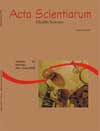<b>Glycogenolysis response to adrenergic agonists in the liver of rats treated with monosodium glutamate (MSG)</b> - DOI: 10.4025/actascihealthsci.v28i2.1103
Abstract
Administration of MSG to neonate rats causes lesions in the arcuate nucleus (AN), followed by a syndrome of neuroendocrine dysfunction characterized by obesity and decreased sympathetic activity. The aim of the present investigation was to examine the responses of hepatic glycogenolysis to α- and β-adrenergic agonists in rats’ treatment with MSG. Male Wistar rats received subcutaneous injections of MSG (4 mg g-1 body weight) or hyperosmotic saline (controls) during five days after birth. Ninety days after treatment, the livers of the MSG or controls rats were perfused in situ with epinephryne and α- and β-adrenergic agonists. Epinephryne, Isoproterenol and phenylephrine increased glycogenolysis in the MSG-treated rats, compared to the controls (50 ± 2.8 Vs 17 ± 0.89 μmol min-1 g-1 of liver, p < 0.0001; 64 ± 0.15 Vs 37 ± 0.39, p < 0.0001; 35 ± 2.48 Vs 27 ± 0.98, p < 0.05, respectively). Results indicated that the lesion in the AN increased glycogen catabolism to adrenergic agonists, possibly, due to the reduced activity of the sympathetic-adrenal axisDownloads
Download data is not yet available.
Published
2008-03-13
How to Cite
Torrezan, R., Grassiolli, S., de Almeida Brito, N., & de Freitas Mathias, P. C. (2008). <b>Glycogenolysis response to adrenergic agonists in the liver of rats treated with monosodium glutamate (MSG)</b> - DOI: 10.4025/actascihealthsci.v28i2.1103. Acta Scientiarum. Health Sciences, 28(2), 175-179. https://doi.org/10.4025/actascihealthsci.v28i2.1103
Issue
Section
Pharmacy
DECLARATION OF ORIGINALITY AND COPYRIGHTS
I Declare that current article is original and has not been submitted for publication, in part or in whole, to any other national or international journal.
The copyrights belong exclusively to the authors. Published content is licensed under Creative Commons Attribution 4.0 (CC BY 4.0) guidelines, which allows sharing (copy and distribution of the material in any medium or format) and adaptation (remix, transform, and build upon the material) for any purpose, even commercially, under the terms of attribution.
Read this link for further information on how to use CC BY 4.0 properly.























5.png)







